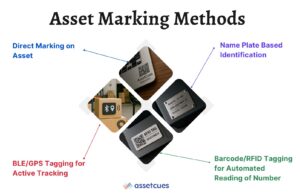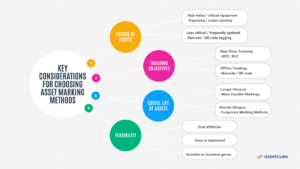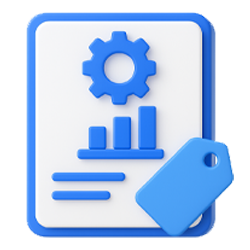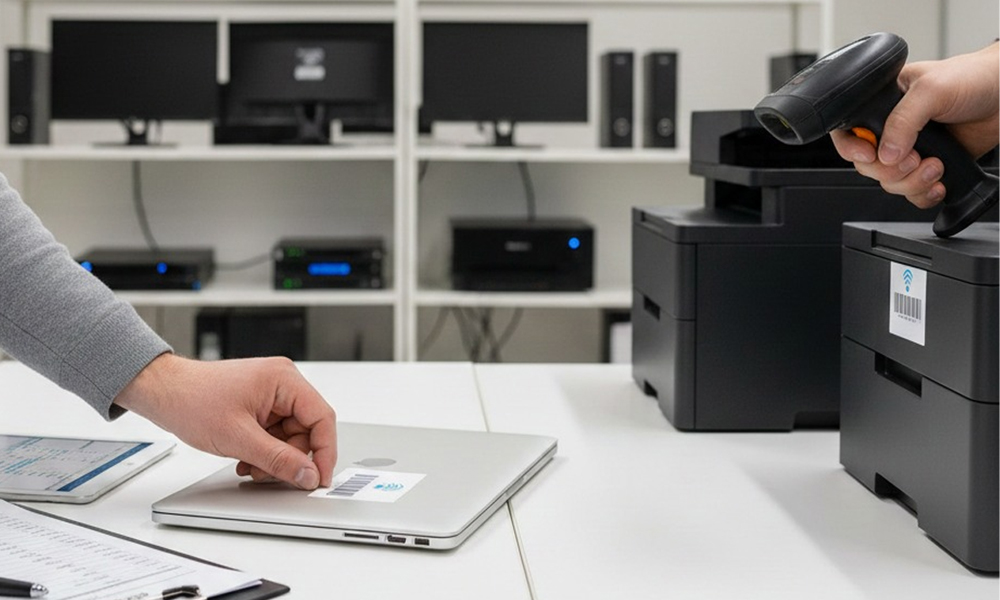Introduction
Effective asset management is crucial for organizations to efficiently track, monitor, and maintain their physical assets. Whether it’s equipment, tools, machinery, or IT assets, ensuring each asset is uniquely identifiable improves efficiency. It also reduces losses and meets compliance requirements.
Asset marking assigns each asset a unique ID, enabling accurate and consistent tracking. Consequently, it links physical assets to digital registers for better accountability and visibility. Moreover, using barcodes, RFID tags, or engravings reduces errors and helps prevent unauthorized asset theft.
What is Asset Marking?
Asset marking assigns unique identifiers using tags or engravings to track physical assets. Typically, these include serial numbers, asset numbers, or equipment numbers linked to digital records. Moreover, they appear as nameplates, barcode tags, QR codes, RFID tags, or engravings. As a result, businesses can efficiently manage assets throughout their entire lifecycle.
The main goal is simplifying asset tracking by making identification and location easier. Each marked asset allows quick register updates and supports accurate audit execution. Moreover, asset marking enhances security by preventing theft and unauthorized use. This method offers a cost-effective solution to maintain efficient asset management practices.
Asset Marking Methods
Since different assets have unique needs, various asset marking methods serve specific tracking requirements. Below are the four most commonly used methods for asset marking:
-
Direct Marking on Asset
Direct marking uses engraving, etching, stamping, or laser to permanently mark assets. As a result, it adds security by resisting tampering and suits high-value or critical items.
-
Name Plate Based Identification
Nameplates, made of metal or plastic, display serial numbers, manufacturer info, and compliance codes. However, they offer less durability and security compared to barcodes or QR codes.
-
Barcode/RFID Tagging for Automated Reading of Numbers
Barcode and RFID tagging enable fast, automated asset identification using machine-readable codes. While barcodes need line-of-sight, RFID allows contactless reading and real-time updates.
-
BLE/GPS Tagging for Active Tracking
BLE and GPS tags provide real-time tracking of mobile or location-sensitive assets. BLE uses Bluetooth signals, while GPS delivers satellite-based geolocation for continuous monitoring.

Benefits of Asset Marking
Asset marking provides a range of benefits that streamline asset tracking and enhance overall management efficiency. Some of the key advantages include:
-
Improved Accuracy in Asset Tracking
By assigning a unique identifier, businesses reduce errors from manual asset tracking. Asset marking ensures consistent accounting and enables real-time updates to asset registers. As a result, it minimizes risks of misidentification and unintentional asset misplacement.
-
Reduced Asset Loss, Theft, and Mismanagement
Clear and visible asset identification plays a crucial role in preventing theft and unauthorized usage. When each asset is uniquely identifiable, it becomes much harder for assets to be misplaced, lost, or stolen. Their movements can be tracked with ease.
See how automation enhances asset tracking >>
-
Enhanced Compliance and Audit Efficiency
Asset marking simplifies audits by making assets easier to identify and verify. Clearly marked assets let auditors quickly scan and confirm presence and condition. As a result, audits become faster and more efficient across all locations. This reduces downtime and lowers resources spent on manual asset verification.
-
Efficient Asset Management
Asset marking helps businesses manage assets more efficiently across the entire lifecycle. It improves tracking accuracy while reducing manual tasks and administrative workload. As a result, organizations save time, streamline operations, and focus on strategic business activities.
-
Cost-Effective Solution
Compared to traditional manual tracking methods or less efficient asset management systems, asset marking is a cost-effective solution. It reduces the need for manual data entry, prevents asset loss, and lowers costs related to mismanagement and administrative inefficiencies.
Key Considerations for Choosing an Asset Marking Method
Selecting the right method depends on several factors that ensure the method aligns with business needs and asset requirements. Some of the key considerations when choosing an asset marking method include:
-
Nature of Assets and Their Usage
The type of asset and its usage play a significant role in determining the best marking method. High-value assets or critical equipment may require durable and permanent markings, such as engraving or laser etching. Less critical or frequently updated assets might benefit from more flexible options like barcode or QR code tagging.
-
Tracking Objectives
Different asset marking methods support specific tracking goals and operational priorities. For real-time tracking, technologies like GPS or BLE tagging offer the best results. In contrast, barcode or RFID work well for simpler, offline tracking needs. The method should match required automation and update frequency for optimal efficiency.
-
Useful Life of the Asset
The useful life of an asset plays a role in determining the longevity of the asset marking. Assets with a longer lifecycle, such as machinery or vehicles, require more durable markings. Assets with a shorter lifespan, such as office equipment or IT devices, can use temporary marking methods like stickers or labels.
-
Feasibility
Feasibility involves evaluating the practical aspects of implementing an asset marking system. This includes considerations such as cost, ease of implementation, and the complexity of integrating the marking method into existing asset management systems. The method chosen should be cost-effective, easy to apply, and scalable as the business grows.

Implementing Asset Marking
Successfully implementing an asset marking system requires careful planning and execution to ensure a smooth transition and long-term effectiveness. The following steps outline the key components of an effective asset marking implementation:
-
Identify Assets and Select Suitable Marking Techniques
The first step in asset marking is identifying assets that require marking. This involves evaluating value, usage, and location to choose the correct method. Once identified, businesses select marking techniques based on visibility and tracking needs. Additionally, they consider durability to ensure long-term asset identification.
-
Integration with Asset Management Systems
After choosing the marking method, integrate it with asset management software for accuracy. This links marked assets to digital records for real-time tracking and audits. Often, integration needs customization or specialized tools for seamless system communication. Consequently, data flows smoothly between the marking system and management platform.
-
Employee Training and Awareness
Proper training is essential to adopt asset marking successfully across the organization. Therefore, employees must understand its purpose and learn to update data using asset management software.
-
Regular Monitoring and Maintenance
Once businesses implement the asset marking system, they should establish a routine to monitor and maintain the markings. They must regularly check the condition of asset tags or markings to ensure readability and durability. Businesses should also conduct regular audits to verify proper asset accounting and keep asset data updated.
Asset marking is a part of asset tagging. Learn how to implement complete system in our published comprehensive guide – “Implementing Asset Tagging System: A Comprehensive Guide”
History of Asset Marking
The practice of asset marking has evolved over centuries, with early methods focusing on basic identification and ownership marking. As industries grew and technology advanced, so did the techniques used to identify and track assets. Below is an overview of the history of asset marking and how it has developed over time:
-
Early Beginnings: Simple Identification Marks
The earliest forms of asset marking date back to ancient civilizations. Tools and property were marked with symbols, engravings, or stamps to indicate ownership. These markings were rudimentary but effective in distinguishing valuable items and preventing theft, particularly in trade and agricultural societies.
-
Industrial Revolution: Expansion of Marking Methods
During the Industrial Revolution, expanding manufacturing required improved asset tracking systems and practices. Factories began marking machinery with serial numbers and unique identifiers for better control. This enhanced inventory accuracy and extended asset lifespan significantly over time. Consequently, metal nameplates and hand-stamped IDs became standard for marking equipment.
-
20th Century: The Advent of Barcode Technology
The 20th century saw major advances in asset marking, especially with barcode technology. Introduced in the 1970s, barcodes transformed tracking through faster, more accurate identification. This shift enabled automation and reduced reliance on manual asset tracking systems. As a result, businesses improved efficiency and operational consistency.
-
Modern Day: RFID, QR Codes, and Beyond
In recent decades, asset marking advanced with RFID tags and QR codes for wireless tracking. These technologies enable real-time monitoring, improving speed and remote asset visibility. Innovations like GPS and BLE tags further enhance geolocation for tracking mobile or high-value assets. As a result, businesses gain greater control and responsiveness.
Future Trends in Asset Marking
As technology continues to advance, the field of asset marking is evolving rapidly. Consequently, here are some key trends shaping the future of asset marking and tracking:
-
Technological Advancements in BLE, GPS, and IoT-Enabled Systems
The future of asset marking aligns closely with the rise of Internet of Things (IoT). IoT systems enable real-time tracking using sensors and communication technologies like BLE and GPS. As a result, businesses can track remote or mobile assets with improved accuracy. Moreover, deeper IoT integration enhances visibility into asset location and current condition.
-
Increased Use of Artificial Intelligence (AI) in Asset Tracking and Management
Artificial Intelligence (AI) will play a pivotal role in advancing asset marking and tracking. It automates processes, analyzes asset data, and provides predictive insights for maintenance. As a result, businesses optimize utilization and proactively manage physical assets. Therefore, AI improves decision-making and drives cost-efficient resource management.
-
Integration of Augmented Reality (AR) for Asset Identification
Augmented Reality (AR) is becoming a powerful tool for asset identification and tracking. Using AR devices or apps, users instantly scan assets and access detailed information. This includes status, maintenance history, and location for faster, more efficient decision-making. As a result, AR improves user experience and supports transformation across logistics, manufacturing, and healthcare.
-
Blockchain for Secure Asset Tracking
Blockchain technology is gaining traction in asset management for secure data recording. By storing asset data on blockchain, organizations create tamper-proof digital records for tracking. This improves system integrity, reduces fraud, and enhances security and transparency. It’s especially valuable for high-value assets or those under strict compliance requirements.
Conclusion
Asset marking plays a vital role in streamlining asset tracking and management processes. It allows businesses to track, monitor, and maintain assets more efficiently and securely. By using unique identifiers, organizations reduce errors, improve compliance, and optimize asset practices. Moreover, technologies like IoT, AI, AR, and blockchain promise automation, accuracy, and enhanced security.
As businesses prioritize efficiency and risk management, modern asset marking becomes essential. These methods improve tracking, strengthen asset practices, and support competitive advantage. By investing wisely, companies enhance visibility and control over physical assets. Furthermore, it delivers long-term benefits that support growth and sustainability efforts.
FAQs
Q. What is asset marking?
A. Asset marking assigns a unique identifier to each asset using visible tags or markings. In turn, this links assets to digital records for efficient tracking and lifecycle management. Consequently, it improves accuracy, reduces losses, and simplifies audits across the organization.
Q. What is an asset marker?
A. Typically, asset markers are small, adhesive-backed labels that display a company name and logo. In addition, they often include serial numbers and barcodes for identification and tracking.
Q. What information is typically included on an asset tag or marking?
A. Asset tags usually display a unique asset ID, serial number, or equipment number. You may also include asset description, manufacturer details, and acquisition date. This information ensures each asset is easily identified and tracked in the asset management system.
Q. Can asset marking be integrated with software systems?
A. Yes, indeed. Modern asset marking methods like RFID and barcodes are specifically designed to integrate seamlessly with asset management software. As a result, they enable automated tracking, real-time updates, and accurate reporting.









